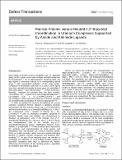Radical anionic versus neutral 2,2′-bipyridyl coordination in uranium complexes supported by amide and ketimide ligands
Author(s)
Diaconescu, Paula L; Cummins, Christopher C
Downloadradical_anionic.pdf (400.7Kb)
OPEN_ACCESS_POLICY
Open Access Policy
Creative Commons Attribution-Noncommercial-Share Alike
Terms of use
Metadata
Show full item recordAbstract
The synthesis and characterization of (bipy)₂U(N[t-Bu]Ar)₂ (1-(bipy)₂, bipy = 2,2′-bipyridyl, Ar = 3,5-C₆H₃Me₂), (bipy)U(N[1Ad]Ar)₃ (2-bipy), (bipy)₂U(NC[t-Bu]Mes)₃ (3-(bipy)2, Mes = 2,4,6-C₆H₂Me₃), and IU(bipy)(NC[t-Bu]Mes)₃ (3-I-bipy) are reported. X-ray crystallography studies indicate that bipy coordinates as a radical anion in 1-(bipy)₂ and 2-bipy, and as a neutral ligand in 3-I-bipy. In 3-(bipy)₂, one of the bipy ligands is best viewed as a radical anion, the other as a neutral ligand. The electronic structure assignments are supported by NMR spectroscopy studies of exchange experiments with 4,4′-dimethyl-2,2′-bipyridyl and also by optical spectroscopy. In all complexes, uranium was assigned a +4 formal oxidation state.
Date issued
2014-12Department
Massachusetts Institute of Technology. Department of ChemistryJournal
Dalton Transactions
Publisher
Royal Society of Chemistry
Citation
Diaconescu, Paula L. and Christopher C. Cummins. “Radical Anionic Versus Neutral 2,2′-Bipyridyl Coordination in Uranium Complexes Supported by Amide and Ketimide Ligands.” Dalton Transactions 44, 6 (2015): 2676–2683 © 2015 Royal Society of Chemistry
Version: Author's final manuscript
ISSN
1477-9226
1477-9234